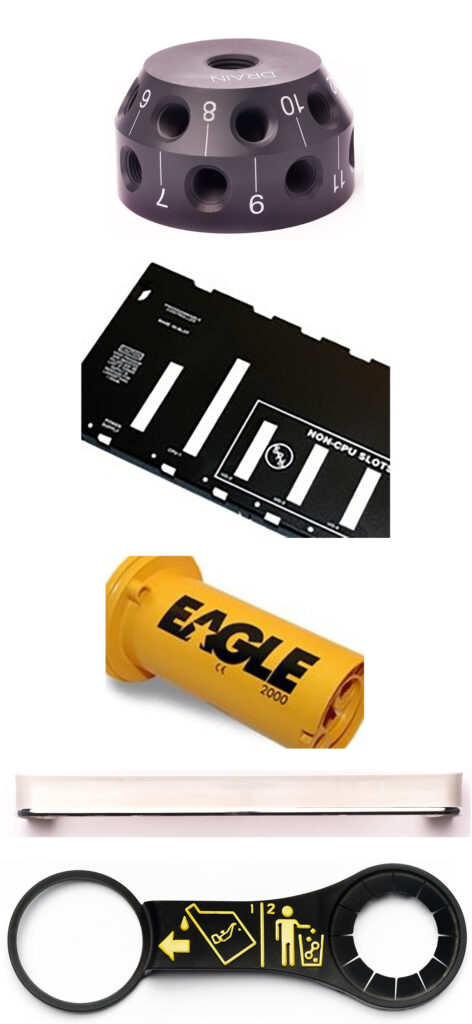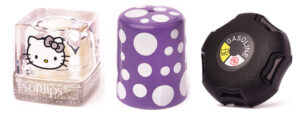A resource sponsored by SPE’s Decorating & Coating Division
Contract plastics decorators are faced with all types of applications daily. The contract decorator must be extremely flexible and provide a variety of decorating services to meet the needs of its plastic molding customers. Steve Brock, sales manager for Unique Assembly & Decorating, shared common challenges in contract decorating applications and the solutions his company employs to deliver a quality end-product to the customer.

When a decorator has the ability to offer several types of decorating processes, what questions should be asked to determine the best method for the application?
With new inquires, it typically starts with the part. If a part drawing is available, that helps determine the best method to decorate. But when a drawing is not available, then contract decorators need to get as much information as possible about the part. Key pieces of information include the material being used and the dimensions.
Part color also is important when determining which decorating method will be used. When decorating white or lighter-colored parts with pad printing or screen printing, there are fewer concerns about matching PMS ink color. However, when decorating black or darker-colored parts, a double hit may be required to match the ink color when pad printing; however, there is less of a concern if the part is screen printed because screen printing lays down a thicker, more opaque layer of ink. Due to the opaque pigment or aluminum layer in foils used with hot stamping, the part color is not a factor.
Then, the discussion moves onto the artwork: How many colors are in the image, and how large will the image be? If the image is multi-color, then pad printing likely would be the best solution at our facility because we have various multi-color pad printing machines that can print one to five spot colors and 4-color process. But if the image is larger than a 4” circle, then screen printing will be required.
It’s also important to know if the part or artwork will require decorating in more than one location on the part. For projects that require multiple image locations, multiple passes may be unavoidable. With smaller parts (Image 1a), the option exists to use a multi-color pad printer and custom tooling to print multiple locations in a single pass.
The last piece of the puzzle is the quantity. How many parts will be decorated? Will the order repeat? If the project will repeat, then the contract decorator needs to know the run size and how often repeat orders will be received. Once the quantity information is available, then a decorator can work with each customer to determine the decorating process that will produce the highest quality and at the fastest rates – which typically is the most economical as well.
After getting all the details, the contract decorating company either will recommend pad printing, screen printing, hot stamping or digital inkjet printing, due to the parameters of each process. While there always will be exceptions, there is some basic information that can be used to help each customer decide which decorating process is right for the project under consideration.
Pad Printing: Of all the product decorating services offered by my company, pad printing is the most versatile and, therefore, the most often used. With pad printing, nearly any rigid material (plastic, glass, metal, wood, ceramics, etc.) or surface (cylindrical, flat, concave or convex, painted, anodized, raised, etc.) can be decorated. The decoration can be single-color and multi-color images for short runs or high-volume jobs requiring automation. In general, smaller parts with smaller images or parts with curvature in the decorating area likely will be pad printed.
Screen Printing: Larger parts with one-color images typically will be screen printed (Image 1b). Decorators often are called upon to screen print large plastic or metal panels or enclosures.
Screen printing also can be used when decorating cylindrical items, such as rigid tubes, bottles, jars or even small metal bearings (Image 1c). These parts can be screen printed on one side, two sides or with nearly a full wrap.
 Hot stamping: Hot stamping can be used when a customer is looking for a reflective metallic foil appearance – a look not achievable with screen printing or pad printing. Typically, this request for a foil/reflective look has been common in the health and beauty industry. However, this request now is seen from industries, including appliance parts. For example, to decorate a drawer base (Image 1d), we took on this project as a three-pass/three-location hot stamp for a customer while the customer was building automated equipment to decorate all three sides in a single pass.
Hot stamping: Hot stamping can be used when a customer is looking for a reflective metallic foil appearance – a look not achievable with screen printing or pad printing. Typically, this request for a foil/reflective look has been common in the health and beauty industry. However, this request now is seen from industries, including appliance parts. For example, to decorate a drawer base (Image 1d), we took on this project as a three-pass/three-location hot stamp for a customer while the customer was building automated equipment to decorate all three sides in a single pass.
More recently, the attention-grabbing metallic foil look has been requested from cannabis packaging customers that are fighting for attention in this booming industry.
Contract decorators also look to hot stamping when asked to decorate a raised area of a plastic part, such as a bottle tether (Image 1e) or instrument display housing. This process, referred to as tipping, does require a minimum height of .030″ for the raised surface.
Digital Inkjet: This is the newest printing technology that was added to the services offered by my company. This product decorating technology is a direct-to-substrate digital inkjet process that uses 4-color process printing plus white for plastic, glass and metal substrates. The advantage of digital inkjet is that there is little to no tooling costs, such as films, plates or screens. That makes digital inkjet an excellent choice for smaller-run applications. For example, my company digitally inkjet prints plastic soap and hand sanitizer dispensers nearly every day. These are small orders – 100 pieces or less per image – with multi-color images. At these lower quantities, digital inkjet is a much more efficient decorating method, without having to offset set-up charges and plates. Although many have predicted that digital inkjet would replace other decorating methods, the majority of our projects still require the more traditional methods of pad printing, screen printing and hot stamping.
Inks have changed a lot over the last several years. What improvements or challenges have been seen with the inks used for pad printing, digital inkjet or screen printing?
In the past few years, my company has spent the most time researching pad printing and screen printing inks for glass. With an increase of inquiries for printing on glass, contract decorators have looked for more production-friendly inks with better ink adhesion and durability – and have been pleased to find inks that check all three boxes.
There also has been an uptick in inquiries for printing on silicone, and ink solutions are available for this difficult substrate as well.
Most of the inks used are solvent-based, but we do have several pad printing applications that use UV-cured inks and have UV curing units for these applications. The biggest advantage to UV ink is the ink immediately dries or cures once the part passes through the UV-curing conveyors. This is a huge advantage for high-volume projects when the parts are bulk packed (truly tumble-packed in the master boxes). With solvent-based inks, bulk-packing the parts inline is a concern due to the potential for ink-to-part transfer or the concern that the parts could have a blemish in the printed image due to falling off a conveyor into the master carton. With UV-cured inks, this is not a concern.
With the bottlenecks in overseas shipping and other supply chain issues, has there been an effect in your business?
Due to logistical delays from overseas, we are getting quote requests to manufacture projects in the US that originally were intended for overseas manufacturing. A significant part of our customer base is plastic injection molders and various manufacturers that contract their product decorating needs to us. Their customers are exploring domestic manufacturing due these shipping delays and, more importantly, increased shipping cost from overseas.
Describe a recent decorating job that was particularly challenging and what you had to do to get the job completed?
One of the medical device manufacturers that we work with challenged us to decorate a Delrin cap with a dot pattern nearly covering the entire surface. The customer wanted the dots along the side wall and on the top of the cap. The cap has three recessed channels that help the user grip the part. The customer wanted some of the dots to run into these recessed areas. The project was expected to run a few hundred thousand parts per year. So, a solution was needed to match the print requirement and the demand.
Given the recessed areas on the side wall and the domed top, the only option was to pad print these parts. However, printing the sides of the cap in multiple passes was not an option given the anticipated annual volume. To print the side wall of the cap in one pass, the artwork was broken into four sections. Custom tooling was designed and built in-house for a multi-color pad printer that would turn the part four times during the printing process. So, instead of printing the image in one location, we printed four different one-color images in one pass. The top of the cap was printed on a separate one-color pad printer.
Steven M. Brock is the sales manager for Unique Assembly & Decorating and has been with the company for over 20 years, working with customers for their contract decorating needs. Unique Assembly & Decorating, Inc. is an ISO-certified company that offers pad printing, screen printing, hot stamping and digital inkjet printing for rigid plastic, glass, metal, wood and ceramic parts. For more information, visit www.uniquepadprinting.com.


